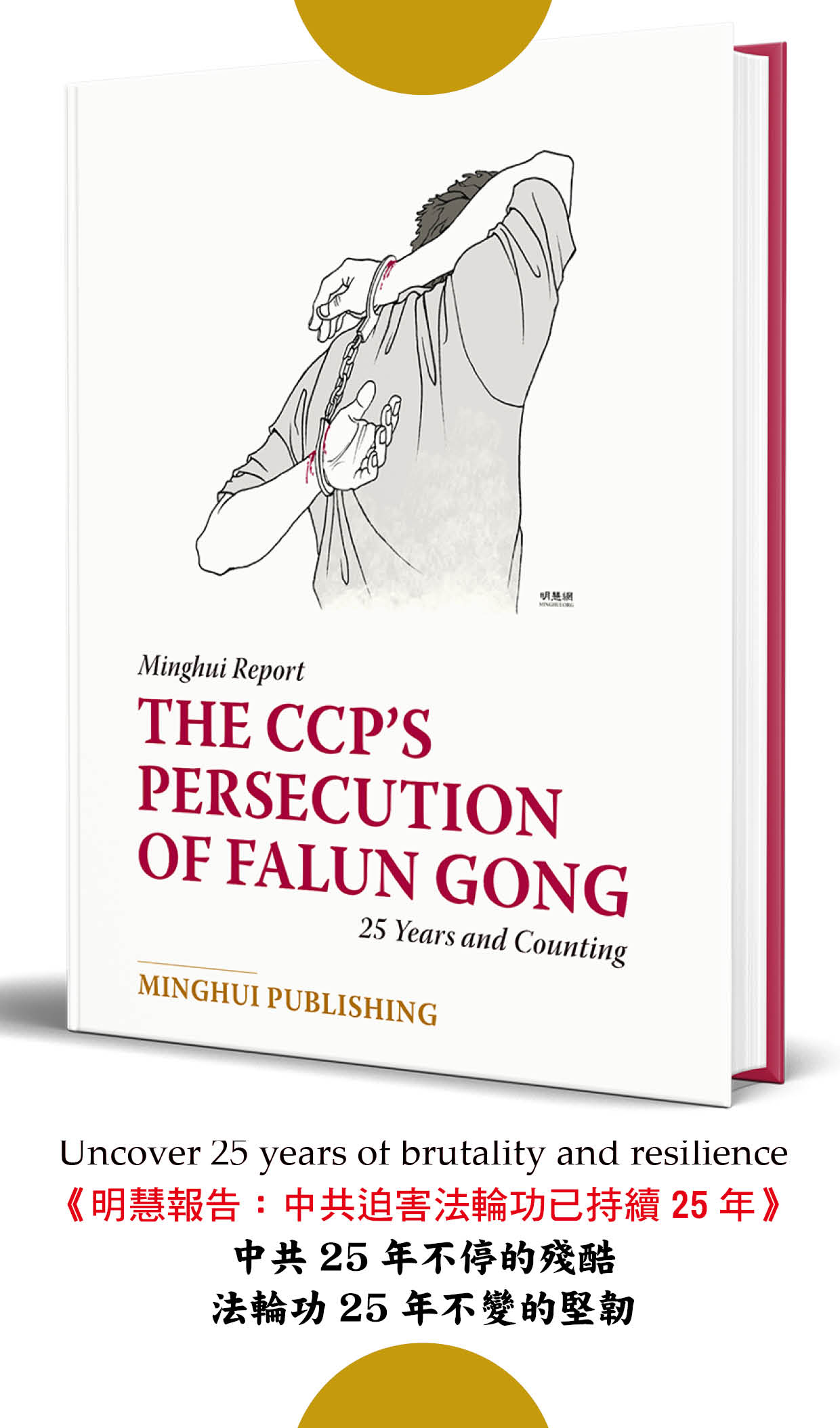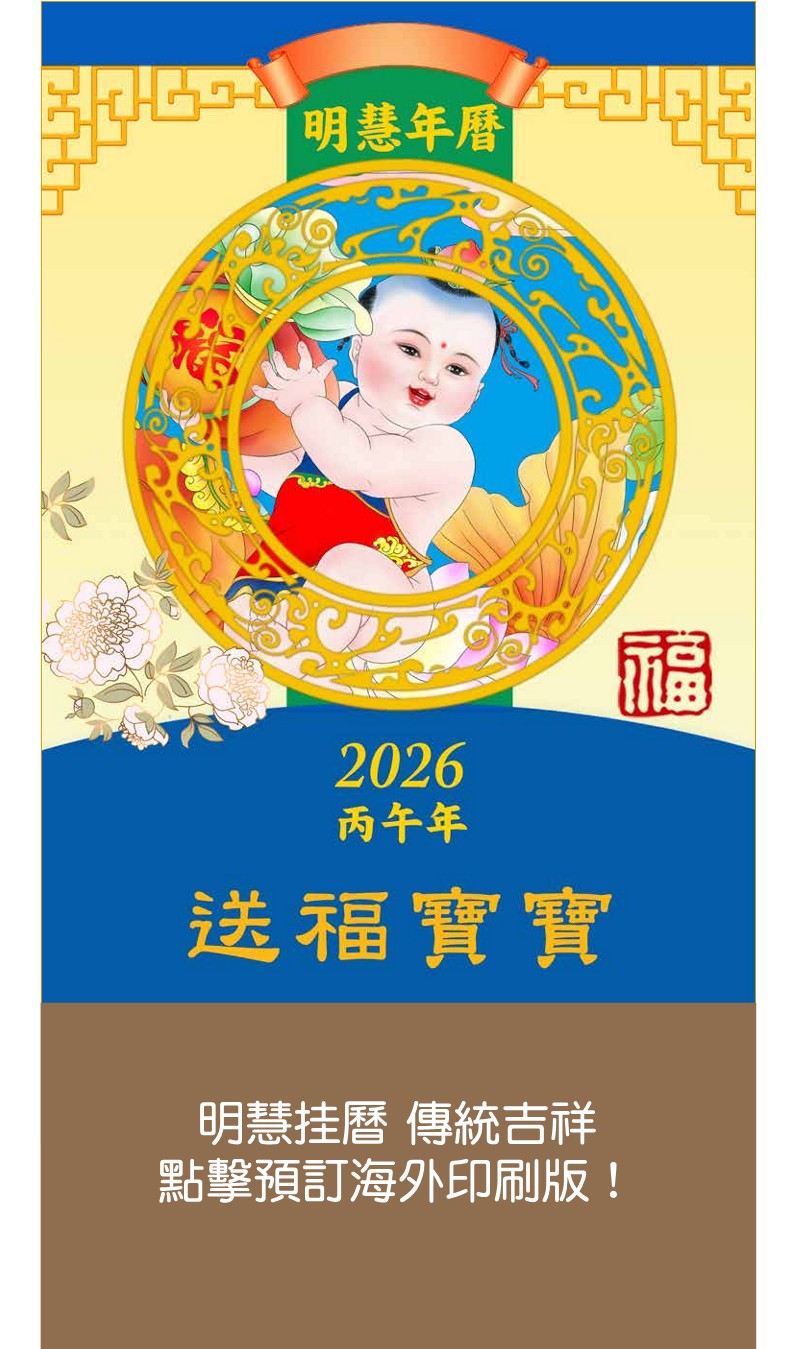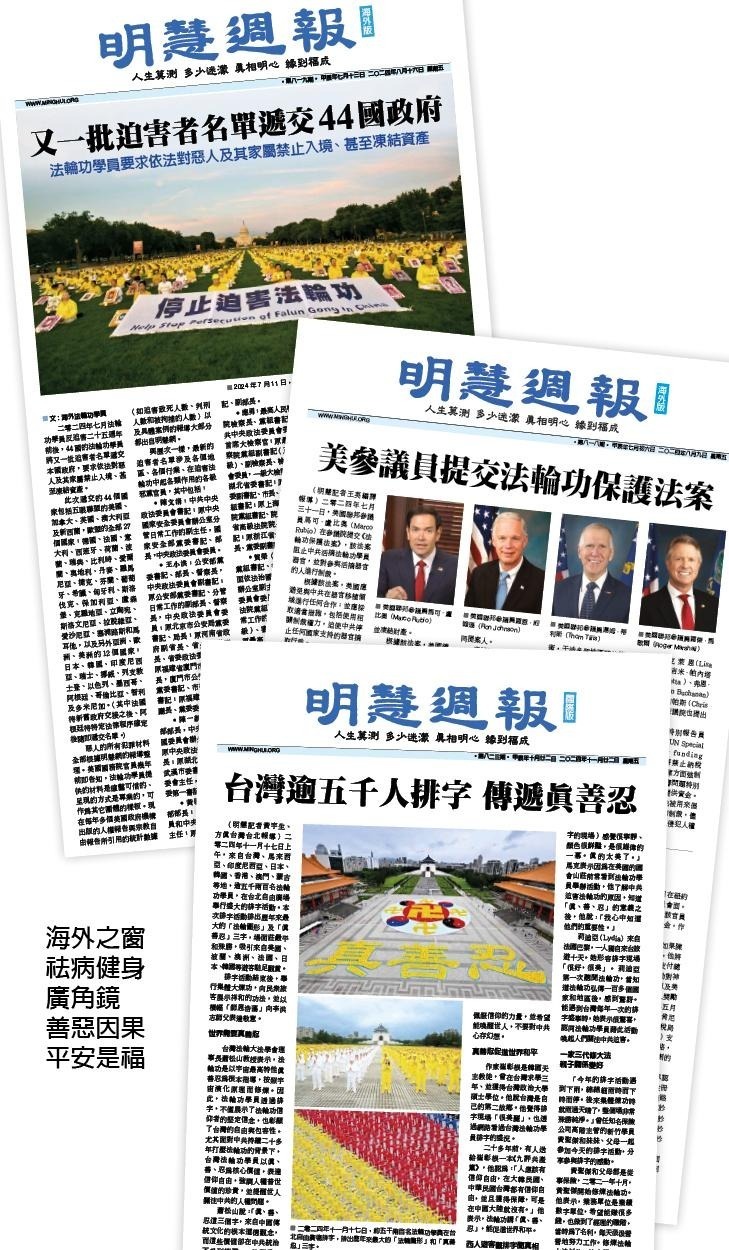香港警方誣告法輪功學員案辯方律師陳詞全文(中英對照)(下)
17. No specific definition of what is and what is not pavement obstruction can be found in case or statute law. Custom and usage (the origins of the Common Law) have enabled the public to make full and varied use of its pavements within practical limits of tolerance safety and convenience. There should be no problem in a wide, clear, lightly used pavement accommodating a smallish demo.
17. 在案例中或成文法例中,都沒有找到對甚麼是和甚麼不是阻街的明確界定。風俗和習慣(普通法的起源)已經能夠讓公眾在行之有效的容忍度、安全及方便的界限內,充份利用人行道作多種用途使用。在一條寬闊無阻而且人流量低的人行道上容納小型示威活動,應該不會出現甚麼問題。
18. The 「custom and usage」 of this pavement from 158 to 162 shows that it readily accommodates long-term clutters (e.g. the storage of 8』 long police barriers across the ped. flow, trees set into the pavement, the sporadically tolerated demo outside 162). It also accommodates short-term clutter (e.g. 5 or 6 large cars parking 3 abreast in 2 rows in front of 160, taxis and cars 「dropping off」 on the pavement outside 160). For the future, the pavement area available for pedestrians between 158 and 162 will be more than halved and the local police have not registered any objection that such a substantial reduction could cause obstruction. Final plans will allow 3 meters, pavement could easily accord Demos. Specifically, the police left their extensive barriers fencing off between 2/3』s and 1/3 of the available pavement for days and days after the 14th of March. They were unlit and unmarked and caused no injury or obstruction to anybody. Although the police alleged explanation for this is interesting, it does not lie in their mouth to say that they would seek to prevent a possible recurrence of a relatively small mobile obstruction (the demonstration) by putting in its place in the pavement an obstruction much larger, less visible and more solid than that which it is seeking to prevent. The police are wildly optimistic to believe that a court will not see through that nonsense. A sensible view is that the pavement outside 160 was wide, open, and could and did successfully accommodate the police fencing operation for days. It is logically and demonstrably unlikely therefore that a small human demo. could cause obstruction injury etc.
18. 從158到162號這段人行道的「風俗和習慣」顯示出,它能輕易地容納長期擺放的雜物(例如在行人來往的地方橫放著8英尺長的警方屏障;在行人路上植樹;偶爾被容忍的在162號外的示威)。它還能容納短期存放的雜物(例如有5到6輛車,3輛一排,分兩行並排於160號前面;的士和車輛在160號外面的人行道上「上落客貨」) 。將來,158到160號這段人行道將會被縮減至少一半,但警方卻沒有收到關於這次人行道大幅度的收窄可能會導致阻街的反對意見。人行道最終會被收窄至3米,因為它容易用作示威。特別是打從3月14日起,警方就一直用大量的路障,封鎖了現場人行道的1/3到2/3的範圍。這些路障未有安上照明也未有標誌,但卻沒有對任何人構成傷害或阻礙。雖則警方對以上現象的所謂解釋相當有趣,說為了防止一個相對地小型的流動障礙(示威活動)再發生,取而代之在人行道上擺放一個更大、更不易覺察以及更結實的障礙物,他們倒沒有說謊話。警察過於樂觀地相信法庭不會識破這種無稽之談。一個合理的觀點就是,在160號外面的人行道寬敞、開闊,而且在實質上能夠容納警方長達幾天的封鎖措施。就這觀點而言,不難合理推斷一個小規模的人為示威行動是不可能導致阻礙或傷害等。
19. Against that background where is there any clear objective and accurate evidence that the demo. might block access to the podium?
(1) The security officers? Both said that the demo blocked the pavement/podium access. That claim is destroyed by the video/photo/and scale plans.
(2) The superintendent? He said that a worker (who could not now be traced or even described) approached to within 2 or 3 feet and 「simply could not get through」 because the gap left 「was only 2' to 3'」. Shown photos which demonstrated the gap to be nearer 9' (now proved by the scale plan videos etc.) the superintendent spoke rather feebly about the possibility of intimidation. The word 「feebly」 is chosen advisedly because:
(a) only the worker himself could give admissible evidence as to whether he was 「intimidated」. He was not called.
(b) there were several uniformed P.C.』s and security officers in the immediate vicinity, to calm any imaginary fears.
(c) Hong Kong`s long standing experience of citizens of demonstrations.
19. 根據以上分析,這裏哪有任何清晰客觀和準確的證據,證明這次示威可能阻塞通往旗桿台的通道?
(1) 那些保安?他們都說請願行動阻塞了人行道和通往旗桿台的通道。這個指控被錄影帶、照片和比例圖則所推翻。
(2) 那個指揮官?他說一個員工(現在已經找不到或甚至不能描述)當走近到請願者2至3英尺範圍之時,因為剩下的間隙「只有2至3英尺」而「簡直不能通過」。展示的照片顯示該空隙接近9英尺寬(現在已由比例圖、錄影帶等證明)。指揮官對(員工)受威嚇的可能性講起來「軟弱無力」。故意選用「軟弱無力」這字眼去形容是因為:
(a) 只有那位員工自己才能就他是否「受到威嚇」提供有效證據。他沒有被傳召。
(b) 那裏有數名穿著制服的警察和護衛員在現場,足以消弭任何假想的恐懼。
(c) 香港面對市民示威的經驗悠久。
20. This, indirect evidence (that some people were obstructed is led to prove a likelihood that people might be obstructed ━ for example workers coming out for lunch (presumably after 1.10 pm!) to a part of Connaught Road totally devoid of Restaurants. The contemporary events on this pavement both before and after March 14 and to the East and West demonstrate beyond reasonable doubt that no one was likely to be obstructed/injured by this relatively small demo.
20. 因為過往曾經有人受阻而去證明人們有可能受阻,例如(假設在下午1時1分之後!)去吃午飯的員工走到一段沒有酒樓的人行道上,這充其量只能是間接證據。然而,在3月14日之前或之後,無論往東還是向西,所發生的當前事件,無庸合理置疑地顯示出不會有人因為這次相對地小型的示威行動而可能受到阻礙或傷害。
21. By the time the P.T.U. units arrived outside 160, no valid observations of 「normal」 traffic could now be made. The police had created a tumult where, in their absence, their had been relative peace and quiet.
21. 當特種部隊到達160號外面時,已經不能就「正常的」人流收集有效的觀察數據。這是因為警方的出現導致一片混亂,而他們不在時場面相對地和平、安靜。
22. AS TO CHARGE 2 (Charge se: Banner)
(1) In their desperation to find a suitable charge, the prosecution grabbed for the straw of section 4A of the Summary Offences Ordinance (Cap.228). Section 4A states 「any person who without lawful authority or excuse sets out or leaves or causes to be set out or left any matter or things which obstruct in a public place …..」. There is evidence before the Court that the accused were holding a banner at all times and even evidence that they at times held it very firmly. There is no evidence that they set out or left it.
Longman』s dictionary defines set out as 「to put a group of things down and arrange it order, such as to set out the dinner on the table」. The Oxford Advanced Learner』s English Chinese Dictionary defines the term as to arrange or display (items). The examples given are to set out chairs for a meeting or to set out the pieces on the chessboard. The Collins Co-build English Dictionary』s states, 「if you set things out, you arrange or display them somewhere. Set out the cakes attractively, using lacy dollies.」 The accused did not set out or leave their banner in a public place. The obvious mischief that section 4A intends to address is when people set out something in a public place, such as a clothesline, some fish left to be dried on the sidewalk, item protruding too far on to the pavement in front of a shop, etc. It could even include a banner that was set out and left unattended. But that is not the case here. Therefore this charge should be dismissed. My Chinese language ability is non-existent, the Chinese standard of my instructing solicitor is a bit better and he, after conferring with others has instructed me that the Chinese character have the same meaning as 「set out」 to which I have already referred. The summer students assisting me and others have confirmed this.
(2) The banner is soft and conspicuous and inherently unlikely to obstruct/injure any pedestrian. Would the banner at 162 be tolerated if it posed any such risk? Both are acceptable clutter on a pavement as wide as this one.
(3) The charge is duplicitous as the banner is part of the same obstruction relied on in Charge 1.
22. 關於第二條控罪(關於對橫幅的指控)
(1) 控方在絕望中想要尋找適合的控罪,他們抓到了簡易程序治罪條例(第228章)第4A節作為救命稻草。第4A節指出:「任何人無合法權限或解釋而陳列或留下(sets out or leaves),或導致陳列或留下任何物品或東西,而這些物品或東西……在公眾地方……造成阻礙……。」在庭上有證據顯示出被告在整段時間裏都是拿著橫幅,甚至有證據顯示有些時候握得很緊。沒有證據顯示他們陳列或留下橫幅。
郎文字典中對set out(陳列)下的定義是「把一組東西放下,然後把東西有序地排列,例如在餐桌上陳列晚餐」。牛津字典界定這一詞為安排或展示(東西)。字典裏所提供的例子如把椅子陳列好以供開會之用,或在棋盤上陳列棋子。在Collin字典寫著:「陳列東西,就是在某處把這些物件安排和展示。利用有花邊的蛋糕紙,把一些蛋糕陳列得很吸引」。那些被告並沒有在公眾地方陳列或留下他們的橫幅。第4A節意在針對的明顯不良行為是人們在公眾地方陳列一些物件例如晾衣繩,在路邊曬乾魚類,在商店門前擺放的物件過分突出人行道等。它甚至包括一條被陳列和留下而無人看管的橫幅,但這不是本案的情況。所以這條控罪應該被撤銷。我沒有使用中文的能力,指導我的事務律師的中文程度比我好一點,他經過和其他人交換意見後告知我中文用的「陳列」一詞與我剛才所指的set out的意思一樣。來幫我的暑期見習學生和其他人也確定了這一點。
(2) 橫幅是軟而顯眼的,它的特質使它不容易構造成對路人的阻礙或傷害。如果它真的能引起以上的危險,那麼位於162號的橫幅會被容忍嗎?在這樣寬闊的人行道上,兩者都是可以接受的雜物。
(3) 這條控罪是重複了,因為橫幅是屬於第一條控罪所指的同一阻礙的其中一部份。
23. AS TO CHARGE 3
The defence relies on the facts set out in paragraphs 1-20 to show that although the individual 「removal」 officers carried out their orders, all the 「arrests」 were flawed because the superintendent』s suspicion (if he held it) was not based on reasonable grounds.
The proper inference from the evidence is that it was impossible to properly observe the obstructive potential of the small demo after the police had fenced the area off. The PTU units, arriving long after this, simply relied on their orders. We do not complain against the individual officers for relying on their orders.
Insofar as the court is obliged to rely heavily on the Senior Police Officer present 「professional view」, that he had seen obstruction committed 「explicitly」, the 「professionalism」 of the police in this operation is not enhanced by the following 「unprofessional events」
(1) An interpreter speaking the wrong language was engaged and continued to be retained even after this fact was known the police. We say that is unprofessional.
(2) Particulars from the Swiss passports were taken down despite their being no F.L.G. blacklist in H.K. We say that is unprofessional.
(3) Notwithstanding advice to go to 162, local practitioners had been regularly subjected to police questioning and banner seizure at that place. This has the appearance of 「police persecution」.
(4) No attempt was made to accommodate the demo further back towards the road but still in front of 160. We say that is unprofessional.
(5) There is evidence from which it can be properly inferred that no.160 enjoys a special relationship with Western Police Station. (e.g. less senior officers than superintendents speak Mandarin, shop keepers complaining of obstruction do not get virtually immediate personal attendance by superintendents, C.I.P.』s, Sergeants and numerous P.C.』s. The removal of the demo on 25/8/01 (placed so far away from any access to 160) without any charges preferred is inexplicable except in terms of special police treatment for 160.
(6) The stand-off heavily controlled for so long by the police (and publicly viewed) created a situation where, if no removals were made, the police would appear to lose face. The removals can be viewed as a face saving operation and the 「warnings」 as 「window dressing」. The warnings had no legal meaning, as I said.
(7) The normal routines of lawful arrest were not observed. There were no formal cautions and no NTPIC』s were served. No logical explanation or apology has been given to the court. Notice the word logical.
(8) The subsequent showings of video films for identification purposes were conducted in flagrant disregard of the police rules designed to safe guard the interests of both sides (relevant rules copied and enclosed).
(9) The prosecution have illogically chosen not to lay charges of resisting arrest. Such charges would have immediately focused the court』s attention on the bone fides of the removal operation outside no.160.
(10) The essential ingredients of this charge includes a requirement that the prosecution prove that the arrests were lawful. That must be done, regardless of any line that the defence might take. The defendants themselves challenged the legality of the arrests from the outset (video transcripts confirm).
(11) The introduction of allegation of previous non-criminal trespass and possible breach of the peace are potentially prejudicial and meaning-less red herrings and, against the background of this case could never provide any reasonable grounds for arrest. Trespass is a civil matter and in the absence of a crime accompanying any trespass, police favour to certain landlords should not be shown.
(12) The absence of formal arresting officers for some of the arrested persons does not assist the prosecution to begin to make its case. Notwithstanding the words in English 「Arrest them」 at 1.10 pm on the video/audio, the prosecution have not brought a speaker to court. This precedes inspector Ho』s instruction at 1.11 pm.
23. 關於第三條控罪(按:關於阻差辦公)
辯方根據據在1-20段所列出的事實指出,雖然每一個負責「清場」的警員是在執行命令,所有的「拘捕」都因指揮官的懷疑(如果他真的認為如此)並沒有合理的依據而出現漏洞。
從證據中得出的正確的推斷是,在警方把現場的範圍封鎖後,不可能對這次小型請願示威行動是否會引起阻礙作出適當的觀察。在其後很久才到場的警察機動部隊,只是在依賴他們接到的命令。我們這裏並不是在投訴個別警察依賴於他們的命令。
既然法庭在很大程度上需要依賴於高級警官的「專業意見」,他說他看到是「明顯」犯了阻街罪,然而,在這次行動中,警員的「專業質素」卻因以下的「不專業事件」而打了折扣。
(1) 警方僱用的翻譯員用了錯誤的語言,而且當他們知道此事後仍然繼續保留這位翻譯員。我們說這是不專業的。
(2) 雖則香港並沒有法輪功的黑名單,但警察仍然把那些瑞士護照的資料記錄下來。我們說這是不專業的。
(3) 儘管警方建議請願者移到162號,本地的學員以往在那裏仍經常受到警察的問話,橫幅也曾被搶走。這裏表現出的是「警察的迫害」。
(4) 警方沒有嘗試讓示威行動繼續在160門前,但在更加靠向路邊的位置進行。我們認為這是不專業的。
(5) 有證據可以適當推斷160號擁有和西區警署的某種特別關係。例如比指揮官低級的警務人員也會說普通話,商店店主投訴受阻礙得不到指揮官、總督察、警長和大量警察的即時個人照顧。除了說160號是受到警方的特別照顧外,根本無法解釋為甚麼2001年8月25日的示威被清場(示威地點距離160號的任何出入口如此遙遠) 而卻沒有人被起訴。
(6) 這個被警方強力控制了那麼長時間的僵持不下的局面(在公眾的角度來看),造成一種形勢,如果不作清場,警方就會失去面子。清場行動可以被視為警方挽回面子的行動,而那些「警告」可以被視為「櫥窗裝飾」。我說過了,警告是沒有法律意義的。
(7) 沒有遵守一般合法拘捕的程序。這裏沒有正式的告誡,也沒有向被捕人士提出拘捕令。沒有向法庭作出合乎邏輯的解釋或道歉。注意「合乎邏輯「這個詞。
(8) 其後播放作鑑定用途的錄影帶,可以看到警方明目張膽地無視其應該遵守的為保障控辯雙方的利益而設的規則(有關規則已被影印及已附帶在這文件內)。
(9) 控方選擇不就拒捕作出指控,是不合邏輯。這樣的指控會立刻把法庭的注意力集中在160號外面清場行動的真實情況。
(10) 這條指控的精髓,在於需要控方證明這次拘捕行動合法,無論辯方將會如何選擇,這是必須要做到的。而被告們一開始就質疑今次拘捕行動的合法性。(錄影帶的謄文可以證實)
(11) 用過去的不構成犯罪的擅自進入和可能破壞安寧作為論據而作出指控是存有偏見和毫無意義地轉移注意力的做法,而鑑於本案的背景,這些都絕不可能成為拘捕行動的合理理由。擅自進入屬於民事範疇,在沒有附帶任何犯罪行為的情況下,警方不應對某些業主表現偏袒。
(12) 對今次被捕的其中一些人士缺乏正式的拘捕人員在場,增加了控方使案情成立的難度。儘管在錄影/錄音帶上可聽到在一時十分的時候有人用英文說了「拘捕他們」的字句,但控方沒有把說話的人帶到庭上。這要比何督察在一時十一分所發出的指示要早一點。
24. AS TO CHARGE 4 (Assault)
(1) D5 has not been proved to have been lawfully arrested.
(2) The police video shows a contact only when D5』s mouth is closed.
(3) Neither the victim』s medical report nor the photographs show any bite.
(4) Accidental contact has not been ruled out.
24. 關於第四條控罪(襲警)
(1) 控方未能證明D5(第五被告)是被合法拘捕的。
(2) 警方的錄影帶只顯示警察與第五被告接觸的時候,第五被告的口是合上的。
(3) 受害者的驗傷報告和照片都沒有發現任何被咬後所留下的傷痕。
(4) 不能排除意外觸碰的可能性。
25. AS TO CHARGE 5 (one of week incidents)
(1) D10 has not been proved to have been lawfully arrested.
(2) D10 is on video for all of her removal from the van.
(3) That continuous video shows her hand gripping and damaging a right side epaulette.
(4) Wong Mei Po (who had viewed this video) first said in evidence that her R epaulette had been damaged. Only when she was shown a police photograph did she 「remember」 that it was her 「left」.
(5) Wong Mei Po had viewed the video without the police rules being observed. Her evidence is confused and totally inconsistent with the video. It may have been affected by this irregular viewing.
(6) Accidental but vigorous contact cannot be ruled out.
(7) The 「injuries」 photographed could have occurred at any stage of the removals. Never have so many phothographs been taken of so few injuries.
25. 關於第五條控罪(證據薄弱的其中一例。按:關於D10襲警)
(1) 未能證明D10是被合法拘捕的。
(2) D10被帶下警車的所有舉動全部被錄影。
(3) 這個連續錄象顯示她的手緊握並弄損了右邊的一個肩章。
(4) 王美寶(她已看過這錄像)第一次作證時說,她右邊肩章被損壞,後來當她看了一張警方的照片,才「記得」應該是「左邊」。
(5) 王美寶在沒有遵守警方的守則的情況下看了該錄像。她的證供混亂,及完全與錄像不相符。可能是受到不合常規觀看錄像的影響。
(6) 不能排除有偶然而猛烈的接觸。
(7) 被拍攝的「受傷」可能在清場行動的任何一個環節中發生。從來都沒見過,這麼少的傷處卻拍了這麼多照片。
26. AS TO CHARGE 6
(1) D10 has not been proved to have been lawfully arrested.
(2) Chan Wai Man accepted that a struggling heavy woman, held by six W.P.C.』s, could have reached up to grip her shoulder neck and shirt to avoid being dropped i.e. to pull herself up. This would not be an assault.
(3) Chan Wai Man first demonstrated a left side injury. She then demonstrated a right side injury.
(4) Chan Wai Man has also been exposed to irregular video showing which may have affected her evidence.
(5) The fact that the incident only lasted 2 seconds may have prompted 「the victim」 to make the concession at (2) above.
(6) No injury or mark was found on her neck.
(7) The 「supporting」 witness who claims to have seen these assaults saw no 「actual scratching」 (charge 5); demonstrated different sides of the neck and could not rule out a suddenly released hand, clutching for something to pull herself up by.
26. 關於第六條控罪(按:關於D10襲警)
(1) 未能證明D10是被合法拘捕的。
(2) 陳慧雯同意一名掙扎中的笨重女士被六名女警抬走時可能會伸手緊握她的肩膀、頸和衣服,以避免跌下來,意即把自己扯上去。這並不算襲警。
(3) 陳慧雯最初展示左邊受傷,但後來又展示右邊受傷。
(4) 陳慧雯同樣不合程序地觀看過錄像 ,這可能會影響她的證供。
(5) 整個事件只維持了2秒,這個事實可能促使「受害者」作出上述 (2)的讓步。
(6) 在她的頸上找不到任何傷口或傷痕。
(7) 另一名「支持」的目擊者宣稱看見襲警,但看不見「實際被抓傷的傷口」(指控5);她展示頸項的不同位置,不能排除被告突然鬆開的手要抓住一些東西把自己拉起來。
27. AS TO CHARGES 4, 5 & 6
In the light of the force and pain which these ladies were exposed to in chaotic circumstances, the charges of assault are fundamentally unfair to these defendants. The pain inflicted by the pressure technique is 「inhuman treatment」 and maybe inhuman treatment is light of the Bill of the Rights.
27. 關於第四、五和六條控罪
鑑於這幾位女士在混亂的情況下遭到武力對待和引起的痛楚,襲警這項控罪從根本上對這幾位被告是不公平的。以施壓手段製造痛楚是「不人道的對待」,根據人權法可能是不人道的對待。
John Haynes
辯方律師
2002年7月9日




















